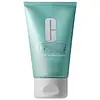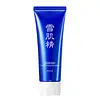What's inside
What's inside
 Key Ingredients
Key Ingredients

No key ingredients
 Benefits
Benefits

 Concerns
Concerns

 Ingredients Side-by-side
Ingredients Side-by-side

Glycerin
HumectantSodium Laureth Sulfate
CleansingSodium Chloride
MaskingLauramidopropyl Betaine
CleansingButylene Glycol
HumectantSucrose
HumectantSodium Hyaluronate
HumectantGentiana Lutea Root Extract
Skin ConditioningLaminaria Saccharina Extract
Skin ProtectingCaffeine
Skin ConditioningAcetyl Glucosamine
Skin ConditioningLaureth-2
CleansingPEG-120 Methyl Glucose Dioleate
EmulsifyingSodium Sulfate
Benzophenone-4
UV AbsorberSodium Hydroxide
BufferingEDTA
Disodium EDTA
BHT
AntioxidantPhenoxyethanol
PreservativeCI 42090
Cosmetic ColorantGlycerin, Sodium Laureth Sulfate, Sodium Chloride, Lauramidopropyl Betaine, Butylene Glycol, Sucrose, Sodium Hyaluronate, Gentiana Lutea Root Extract, Laminaria Saccharina Extract, Caffeine, Acetyl Glucosamine, Laureth-2, PEG-120 Methyl Glucose Dioleate, Sodium Sulfate, Benzophenone-4, Sodium Hydroxide, EDTA, Disodium EDTA, BHT, Phenoxyethanol, CI 42090
Water
Skin ConditioningMyristic Acid
CleansingGlycerin
HumectantStearic Acid
CleansingPotassium Hydroxide
BufferingLauric Acid
CleansingGlycylglycine
PEG-32
HumectantPEG-6
HumectantSodium Methyl Myristoyl Taurate
CleansingSaccharomyces/Lentil Seed Ferment Extract
EmollientUlmus Davidiana Root Extract
Skin ConditioningBourbon Extract
AstringentPhenoxyethanol
PreservativeSodium Benzoate
MaskingParfum
MaskingTitanium Dioxide
Cosmetic Colorant
 Reviews
Reviews

Ingredients Explained
These ingredients are found in both products.
Ingredients higher up in an ingredient list are typically present in a larger amount.
Glycerin is already naturally found in your skin. It helps moisturize and protect your skin.
A study from 2016 found glycerin to be more effective as a humectant than AHAs and hyaluronic acid.
As a humectant, it helps the skin stay hydrated by pulling moisture to your skin. The low molecular weight of glycerin allows it to pull moisture into the deeper layers of your skin.
Hydrated skin improves your skin barrier; Your skin barrier helps protect against irritants and bacteria.
Glycerin has also been found to have antimicrobial and antiviral properties. Due to these properties, glycerin is often used in wound and burn treatments.
In cosmetics, glycerin is usually derived from plants such as soybean or palm. However, it can also be sourced from animals, such as tallow or animal fat.
This ingredient is organic, colorless, odorless, and non-toxic.
Glycerin is the name for this ingredient in American English. British English uses Glycerol/Glycerine.
Learn more about GlycerinPhenoxyethanol is a preservative that has germicide, antimicrobial, and aromatic properties. Studies show that phenoxyethanol can prevent microbial growth. By itself, it has a scent that is similar to that of a rose.
It's often used in formulations along with Caprylyl Glycol to preserve the shelf life of products.